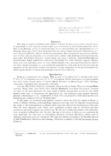Brazilian Problem Soils : Distribution, Characteristics and Utilization
Tropical agriculture research series : proceedings of a symposium on tropical agriculture researches
| ISSN | 03889386 |
|---|---|
| NII recode ID (NCID) | AA00870529 |

Full text
tars15-_1-20.pdf3.19 MB
Five main ecological dominions were defined in Brazil. In those areas occurs a broad variety of soils which in their majority present some type oflimitation to agricultural production. About 86% of the Brazilian surface is covered by what can be called problem soils. Among them Latosols (Oxisols), Dystrophic Red-Yellow Podzolics (Ultisols), Quartz Sands (Entisols) Lithosols (Inceptisols), Planosols (Ultisols, Alfisols, Mollisols) predominate. Maps showing the approximate distribution of these soils are presented. Low nutrient status, acidity, high aluminum saturation (Latosols, Dystrophic Red-Yellow Podzolics, Quartz-Sands and some Cambisols, Lithosols,Planosols and Hydromorphic Soils); shallowness (Lithosols, Cambisols); low water retention capacity (Quartz Sands and some Latosols); excess of water (Hydromorphic Soils, and some Planosols) are some of the main natural constraints to crop production presented by these soils. In the last few years the expansion of the agricultural frontier has become strongly dependent on the use of stressed soils, where a great number of annual and perennial crops has been cultivated.
| Date of issued | |
|---|---|
| Creator | José da SILVA MADEIRA NETO Jamil MACEDO Luiz GUIMARÃES de AZEVEDO |
| Publisher | Japan International Research Center for Agricultural Sciences |
| Volume | 15 |
| spage | 1 |
| epage | 20 |
| Language | eng |
